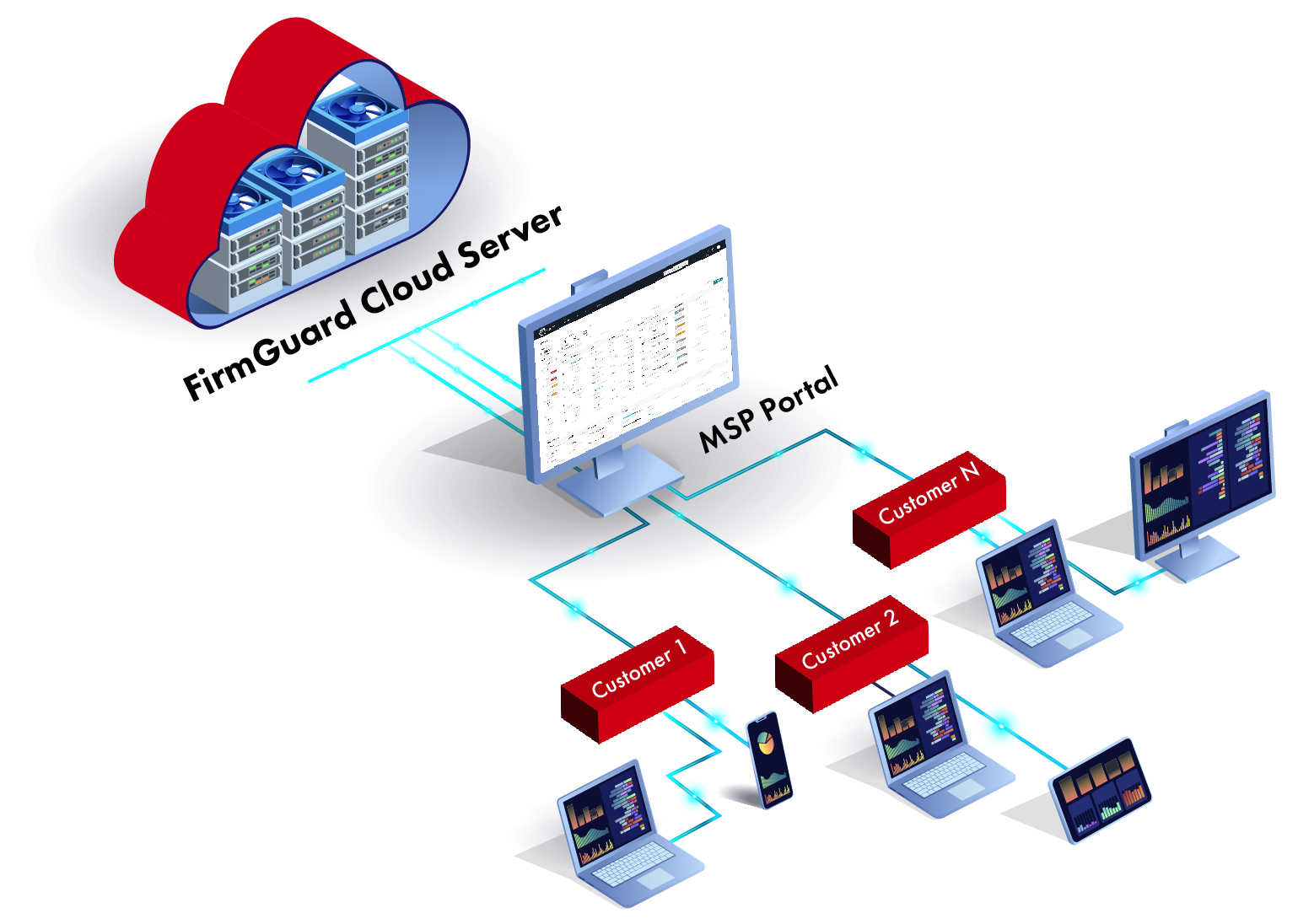What is FirmGuard?
FirmGuard is a comprehensive solution for remotely securing, configuring, updating and monitoring BIOS firmware. It goes beyond traditional antivirus and endpoint detection and response (EDR) by safeguarding the UEFI (Unified Extensible Firmware Interface) BIOS firmware of an endpoint, a critical yet often overlooked component of a device’s security posture.
FirmGuard ensures BIOS firmware integrity by continually monitoring changes to the BIOS and alerting an administrator whenever some potentially malicious activity occurs (SecureCheck). Additionally, FirmGuard enables remote BIOS configuration (SecureConfig) so administrators can easily optimize BIOS settings, by for example, enabling critical features such as Secure Boot to strengthen defenses against unauthorized access and malware. Further, FirmGuard tracks an endpoint’s firmware version (SecureUpdate) and facilitates smooth and consistent UEFI firmware updates. FirmGuard can also be used to forensically wipe (SecureWipe) an endpoint drive(s), complete with a Certificate of Erasure (COE), to meet compliance requirement. For endpoints still operating in legacy BIOS mode, FirmGuard identifies these systems so that adminstrators can recommend removal or update to the more secure UEFI mode (SecureSense).
Importance of BIOS Firmware
Companies have spent billions of dollars protecting endpoints from OS and application-level attacks using EDR/XDR tools. But most have spent almost nothing to protect the BIOS firmware in those same endpoints. This leaves a huge security gap because BIOS is the first software to come up when the power button is pressed, and it is the BIOS which launches the operating system. If BIOS is compromised, that can lead to a hacker taking over complete control of the device, making it critical to have firmware security measures in place.
As CISA notes, hackers are getting better every day at compromising UEFI BIOS firmware and the longer you wait to protect your clients, the more likely they are to experience a devastating exploit.
Adversaries have demonstrated that they already know how to exploit UEFI components for persistence, and they will only get better with practice

Benefits of FirmGuard
- Security – Closing the BIOS firmware security gap for all clients is the right thing to do for any organization. Your clients will thank you for it and will likely never look elsewhere for IT services.
- Compliance – FirmGuard helps ensure compliance with industry standards and guidelines such as those set by NIST, ISO and other regulatory bodies.
Technician Efficiency – With FirmGuard a technician can remotely configure BIOS settings; securely erase an endpoint’s hard drive(s); or get detailed information about an endpoint such as BitLocker status, all without ever leaving his or her seat. This reduces the need for onsite visits, shipping endpoints back and forth or writing scripts to obtain data. - Increase MRR – MSPs regularly charge customers for EDR/XDR tools that protect client endpoints at the OS or application level. FirmGuard fits into that same pricing model but protects at the BIOS firmware level which is an often-overlooked component of a device’s security posture.
- Differentiate Yourself – By incorporating FirmGuard into their service offerings, MSPs can differentiate themselves in a crowded market. By educating clients about the importance of BIOS firmware security and offering tailored solutions, MSPs can build stronger, long-term relationships that drive recurring revenue.
Here is what some of our customers have to say about FirmGuard




UEFI BIOS Malware
Most organizations don’t know much about UEFI BIOS malware. On the Phoenix website we maintain a list of such attacks and some of the more recent ones come with names such as PixieFail, BlackLotus and Moon Bounce. Though these names may sound funny, they are certainly no laughing matter.
BlackLotus UEFI Vulnerability
While many UEFI attacks don’t get much press, BlackLotus is one that Microsoft has talked about extensively because it can be very destructive.
One thing that BlackLotus does is disable Secure Boot which is a mechanism to ensure that only an authenticated version of Windows can be launched by the UEFI firmware. This is something a hacker would clearly like to do because without Secure Boot enabled, the hacker can launch any rogue operating system and thereby turn the endpoint into a personal playground. This is where FirmGuard comes into the picture. If an endpoint has FirmGuard installed on it and Secure Boot is disabled because of BlackLotus, or any other reason, the IT administrator is immediately alerted via the dashboard and can then use SecureConfig to take corrective action–stopping an attack in its tracks.
One final point to note about UEFI malware is that it can be so devastating because of persistence. This means that even if you reinstall Windows on an infected endpoint or swap out the hard drive, you still won’t solve the problem. The reason is because the UEFI firmware sits in its own dedicated flash memory on the motherboard of the endpoint. So, the only way to solve the problem is to update the firmware and the only way to know about it in the first place is with FirmGuard.
How FirmGuard Works
FirmGuard is a secure, cloud-based solution hosted in Amazon Web Services (AWS). The FirmGuard Cloud Server handles all administrative and technical functionality with a direct interface to each client endpoint. A lightweight FirmGuard agent is installed on each endpoint and is easily deployed using any RMM tool. All monitoring and administration is done via the FirmGuard portal.










